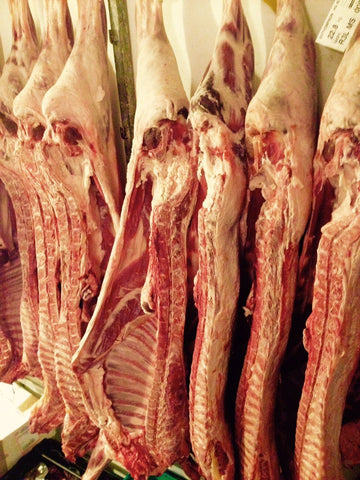What is Hogget?
Superb roasted, slow cooked, pan-fried or grilled, hogget is as versatile as it is flavourful. But what exactly is hogget? And why does it taste so good?
Looking to buy hogget? Shop now >
A year on pasture
Hogget is the word used to describe a lamb in its second spring or summer – so aged between one and two years.
While still tender, a hogget’s extra time on pasture allows it to develop a flavour that is richer and fuller than lamb’s but not as pronounced as older mutton’s. It is this satisfying depth of flavour, together with hogget’s texture, sweetness and versatility, that is helping hogget find new fans among chefs and home cooks.
A traditional British meat
 It will come as no surprise that Salter & King are longstanding members of the hogget fan club. As well as specialising in mutton, we love to recommend hogget to our customers and hear about how they have cooked it.
It will come as no surprise that Salter & King are longstanding members of the hogget fan club. As well as specialising in mutton, we love to recommend hogget to our customers and hear about how they have cooked it.
Traditionally, most ‘lamb’ enjoyed in this country was actually ‘hogget’ – it’s only comparatively recently that we’ve started eating younger animals, known now as ‘spring lamb’. Prior to the creation of today’s modern breeds, few lambs of yesteryear would have gained enough weight in their first year to be considered for eating.
Conversely, many of today’s consumers haven’t even considered eating hogget or mutton, even though its extra six months or so grazing on luscious spring and summer grass undoubtedly gives it the upper hand in the flavour stakes.
Hogget versus lamb for Easter
British spring-born lamb comes into the height of its seasonal best in summer, from around mid-June through to September. Lambs finished in time for spring, on the other hand, will have been born in autumn or midwinter with little time to graze the fresh spring grass that creates so much flavour.
If you’re looking for British free-range lamb for Easter or spring meals, opting for hogget born the previous spring means you can enjoy eating a pasture-fed animal that has lived a natural free-range life. This is the more sustainable choice too – animals born in spring waste less energy keeping warm and ewes need fewer supplementary feeds to help them produce enough milk.
Free Range Hogget from the Somerleyton Estate
Suffolk’s fertile soils are ideal for grazing sheep and we’re proud to source our hogget from an outstanding local producer.
We began working with Somerleyton Estate near Lowestoft in 2019. The listed historic parkland in front of the hall is home to the Somerleyton herd of Welsh Black cattle as well as their Norfolk Horn and Welsh Mountain sheep. The Norfolk Horn is one of the oldest breeds of sheep in the UK. An ancestor of the Suffolk sheep, this local breed almost became extinct in the 1970s so it’s a real treat to be able to enjoy their superb flavour, along with the equally highly esteemed meat of Welsh Mountain sheep.

The 5,000 rolling acres of woods, fields and parkland of the Somerleyton Estate provide an idyllic environment for the flock. With plenty of rich pastures and space to roam, it’s the perfect setting to raise hoggets naturally and slowly for exceptional quality and taste.
Health benefits
When finished slowly on rich pasture, hogget and mutton are highly nutritious, providing high levels of omega-3 fatty acids as well as many other essential vitamins and minerals, including selenium, zinc, B12 and iron. Leaner with lower saturated fat levels than indoor-raised lamb, this high-quality protein source also delivers all nine of the essential amino acids our body needs.
Buying hogget
Our hogget range includes hogget leg, hogget shoulder, hogget chops, hogget cutlets, hogget mince and diced hogget, which we hang for around two weeks to enhance the flavour and texture. Half hoggets are also available with a shoulder, leg, rack, chops, neck fillet, boneless rump and mince.
Our full hogget range is available to order online. Shop now >
A hogget shoulder will feed around six while a leg will easily feed ten (a lamb leg generally serves around eight). If you’re cooking cutlets or chops, we’d recommend allowing two per person.
How to cook hogget
 If you’re hosting a celebration, a slow-roasted hogget leg or shoulder is a mouthwatering centrepiece. Take the joint out of the fridge an hour before cooking to bring it to room temperature then season and rub with oil. We recommend cutting small incisions into the fat and inserting rosemary, garlic and/or anchovies for amazing flavour before covering with foil and slow roasting in an oven at 160ºC for 50 minutes per 500g.
If you’re hosting a celebration, a slow-roasted hogget leg or shoulder is a mouthwatering centrepiece. Take the joint out of the fridge an hour before cooking to bring it to room temperature then season and rub with oil. We recommend cutting small incisions into the fat and inserting rosemary, garlic and/or anchovies for amazing flavour before covering with foil and slow roasting in an oven at 160ºC for 50 minutes per 500g.
Diced hogget, meanwhile, is delicious in slow-cooked casseroles, ragouts and fiery curries – as well as wonderful Irish stews or Lancashire hotpots, along with chops, cutlets, neck or a combination of these.
Like lamb, chops and cutlets are also fantastic cooked quickly over a high heat in a pan or griddle, under the grill, or on a barbecue.
If you’re inspired to give hogget a try, you can browse our full range here >

